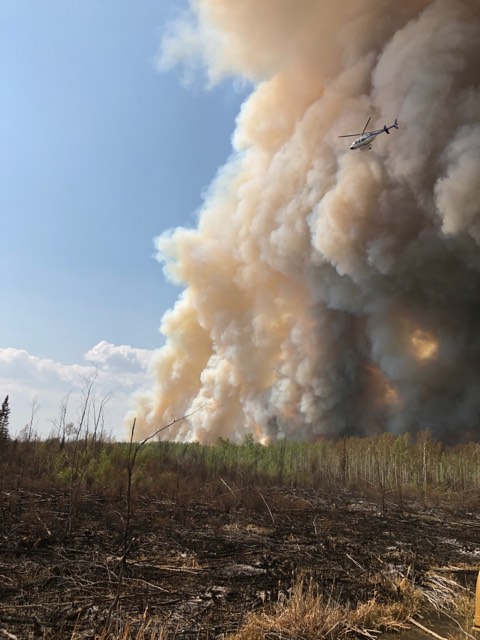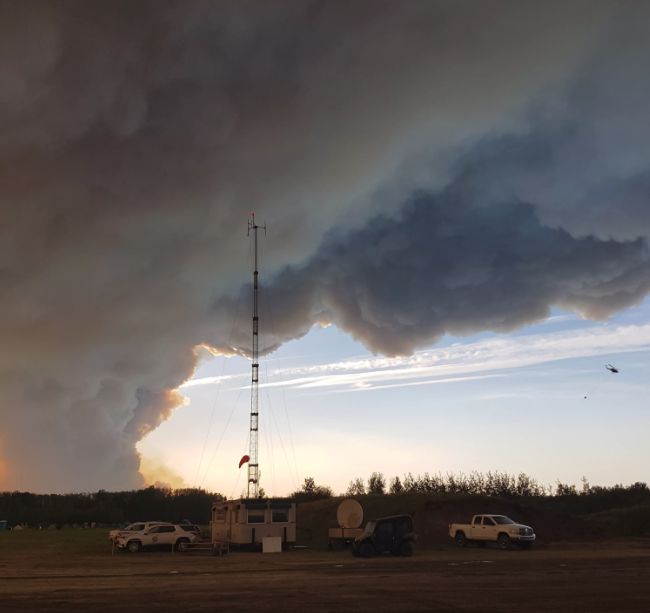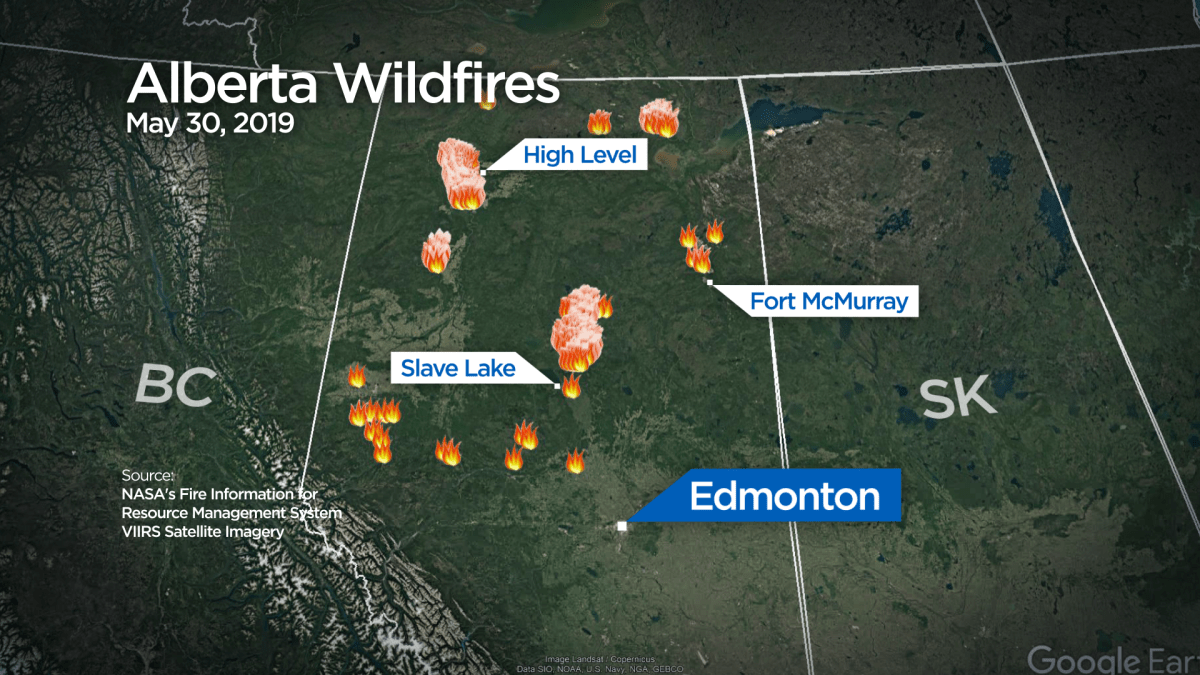The Chuckegg Creek Fire, burning within a few kilometres of High Level, Alta., ballooned in size between Wednesday and Thursday. As of 11 a.m. Thursday, it was approximately 2,300 square kilometres — or 230,000 hectares.

READ MORE: Alberta wildfires: Evacuation alerts and orders in place across the province
On Wednesday morning, it was approximately 1,500 square kilometres.
Alberta Wildfire said it grew by 100,000 hectares in about 48 hours.
“Yesterday, it made a run of a little bit more than 22 kilometres to the south in approximately a 16-hour period,” wildfire information officer Derek Gagnon said.
“At average pace, it was going about 23 metres per minute.”
Whether that rate of growth will continue depends on the weather, Gagnon said, adding lower temperatures were expected Thursday.
“That was an extremely intense wildfire burning very hotly and moving very quickly. So, it went beyond what we were capable of stopping it with the guards we had in place and made that intense run towards the Paddle Prairie Metis Settlement.”
Watch below: Officials from multiple agencies discuss reports of possible property damage in Paddle Prairie due to wildfire.

Alberta Wildfire said the Chuckegg Creek fire experienced extreme fire behaviour Wednesday. “Continued hot and dry conditions along with variable, gusty winds have proved a challenge to firefighting efforts and safety,” the Thursday morning update added.
READ MORE: Northern Alberta wildfires prompt Kenney government to declare disaster, public emergency
The fire grew to the south (towards Paddle Prairie, across Highway 35 by Highway 697, and spotted across the Peace River), west and north (around Watt Mountain).
“There have been no homes or business damaged to date around High Level, but the threat remains,” it said.
High Level Mayor Crystal McAteer, Reeve Josh Knelsen of Mackenzie County and Dene Tha’ First Nation Chief James Ahnassay issued a joint statement late Wednesday on Facebook.
“We know that many of you are very anxious to hear about what is happening with the wildfire and the situation in our communities. Many of you have been out of your homes and away from your work for a long time,” they wrote.
READ MORE: Alberta fire season 2019: Latest status of wildfires, bans and restrictions
The leaders urged patience.
“On Wednesday, the wildfire threatening our communities grew significantly and exhibited extreme and volatile fire behaviour. We simply don’t know for sure what this fire will do next.
“The danger to High Level remains, and the danger to communities in Mackenzie County and the Dene Tha’ First Nation has increased. Four more areas were evacuated … More than 600 of our neighbours had to leave their homes.”
READ MORE: Alberta wildfire continues to grow, but is spreading away from High Level
The goal is to get residents of High Level home by the weekend, the post said.
“But with this wildfire we can’t promise anything. For other communities, we know it will be later. Please be patient with us.
“The situation is constantly changing and there are no firm timelines.”
In the High Level area, about 5,000 people have been out of their homes for more than a week because of the fire.

Alberta wildfire situation update
Alberta Wildfire spokesperson Christie Tucker said Thursday afternoon the last 24 hours have been an “extremely challenging time for firefighters.”
“We saw fires moving very quickly, even at night when they wouldn’t traditionally be moving so quickly… We saw number of them grow significantly over the last 24 hours.
“Conditions are stabilizing a little bit today but we still don’t have foreseeable relief in the near future,” Tucker said.
As of Thursday at 10 a.m., there were 29 wildfires burning across Alberta; 10 of which were listed as out of control.
As of 7:30 p.m. on Thursday, the Jackpot Creek wildfire, formerly west of Steen River, was about 17,000 hectares in size.
The McMillan Complex wildfire, southwest of Bigstone Cree Nation, was over 74,500 hectares. Meanwhile, the Maria Lake wildfire was estimated at 5,500 hectares in size and was expected to burn into the larger McMillan Complex wildfire.
The Battle Complex wildfire in Peace River was estimated to be over 44,000 hectares in size.
Watch below: Christie Tucker from Alberta Wildfire explains the challenges crews have faced as multiple wildfires grew overnight.

The province elevated the operations centre to a Level 4, which means it includes all Alberta government departments, some national stakeholders, and key industry and non-governmental groups.
“For instance, we have a rep from ATCO there,” said Shane Schreiber with the Alberta Emergency Management Agency, “a rep from CN Rail who’s in there… It’s important for us to be able to put all the pieces together.
“There’s no Level 5… We’re at the top level.”
Tucker said there were 600 firefighters from other provinces helping out in Alberta. In total, the government said provincial resources on the ground to battle the wildfires included over 2,300 wildland firefighters and staff, about 200 helicopters and 27 air tankers along with other heavy equipment.
“Currently, the 2019 wildfire season, which started March 1, we’ve seen more than 500 wildfires so far,” Gagnon said. “That number is actually a little bit less than we saw in the 2018 wildfire season. But the number of hectares burned is far greater, as well as some of the wildfires that are burning are closer to communities.”
Since March 1, 2019, more than 374,768 hectares have burned in Alberta.
Other wildfires also experienced significant growth overnight Wednesday into Thursday.
“This fight is going to be a tough one,” Devin Dreeshen, minister of agriculture and forestry, said Thursday afternoon. “The weather is not cooperating… In spite of our best efforts, shifting winds are causing the smoke to drift.”
Other communities evacuated
The smoke is also prompting more evacuations. Between Wednesday and Thursday, the number of people forced out of their homes went from about 5,500 to about 10,000.
The Alberta government issued an emergency alert early Thursday morning for Chipewyan Lake Village, about 450 kilometres north of Edmonton.
Watch below: Kaycee Madu, Alberta’s minister of municipal affairs, updates evacuation notices and compensation details resulting from wildfires in the northern part of the province.

People were being asked to leave immediately because of a rapidly moving wildfire that threatens to cut off access to the area.
Different fires have forced evacuations from the hamlet of Wabasca, the Bigstone Cree Nation and Northern Lights County.
Terry Ungarian, reeve of the County of Northern Lights, said between 250 and 280 people fall under the evacuation order.
“People are very aware that there’s a huge wildfire in close proximity. There’s a range of emotions from being very nervous to… we do live in a boreal forest region and we do have wildfires,” Ungarian said.
“It’s something we live with but how it’s encroaching on other communities is very worrisome.”
He said evacuees had to go south, register at the county office then many dispersed to places such as Grimshaw, Peace River and Grande Prairie.
The town of Manning remains under an evacuation alert.
“The word evacuation draws a lot of anxiety so we have a lot of people that are quite anxious abou the situation. We’ve been trying to keep them calm,” Ungarian said.
There is a temporary access program set up where beef producers are allowed to re-enter the evacuation zone to check on their cattle.
The situation is tightly controlled; residents must register at the county office and have to call back and check in every hour while they are gone. They can also only be out during daylight hours. The temporary access program only permits one re-entry a day.
READ MORE: Northern Alberta MD of Opportunity communities ordered to evacuate overnight due to wildfires
Meanwhile, the town of Slave Lake, which was devastated by a wildfire in 2011, was also put on evacuation alert.
Slave Lake Mayor Tyler Warman said the blaze that’s posing a concern his community was not an immediate threat and people weren’t being forced out like they were more than a week ago in High Level, 485 kilometres to the north.
He said the flames were still about 30 kilometres away from Slave Lake as of midday, but officials wanted residents to be prepared to leave.
“We’ve got a fire, that started around the same time as the High Level one, that’s been north of town for a while,” Warman said. “The wind conditions and the extreme dryness have pushed some of it closer to town.”
Watch below: Nearly 10,000 Albertans have been forced to leave their homes because of wildfires this spring and other communities are on an evacuation alert. Fletcher Kent has the latest from Slave Lake where residents are being told to be ready for a possible evacuation.

Many of the 5,000 people forced out of the High Level area on the Victoria Day long weekend are being housed in Slave Lake.
An evacuation order was issued Thursday afternoon for the hamlet of Marten Beach, about 20 kilometres north of Slave Lake, due to the fire.
“The MD has declared a local state of emergency because of that, but we’re not panicked at this point,” said Warman, who was a town councillor and firefighter during the 2011 wildfire that raced through part of Slave Lake.
He said the fires are bringing back memories.
“We are more prepared than we have ever been. We’re more cautious than we have been in the past.”
Tucker said there are two fires burning near Slave Lake: the Maria Lake fire, which is about 46,000 hectares, and the MacMillan Complex fire, which is about 134,000 hectares.
READ MORE: Wildfire leads to mandatory evacuation order near Mackenzie County campground
READ MORE: Special air quality statements issued in Edmonton, much of Alberta due to wildfire smoke
People in Edmonton awoke Thursday to a thick, smoky haze that turned otherwise blue skies an eerie grey-orange.
Environment Canada issued a special air-quality statement for the Alberta capital, warning that people might experience coughing, throat irritation, headaches or shortness of breath. Children, seniors, and those with heart and lung disease were said to be at special risk.
Watch below: Meteorologist Jesse Beyer has a weather forecast for Thursday, May 30, with a focus on air quality due to wildfires.


















Comments